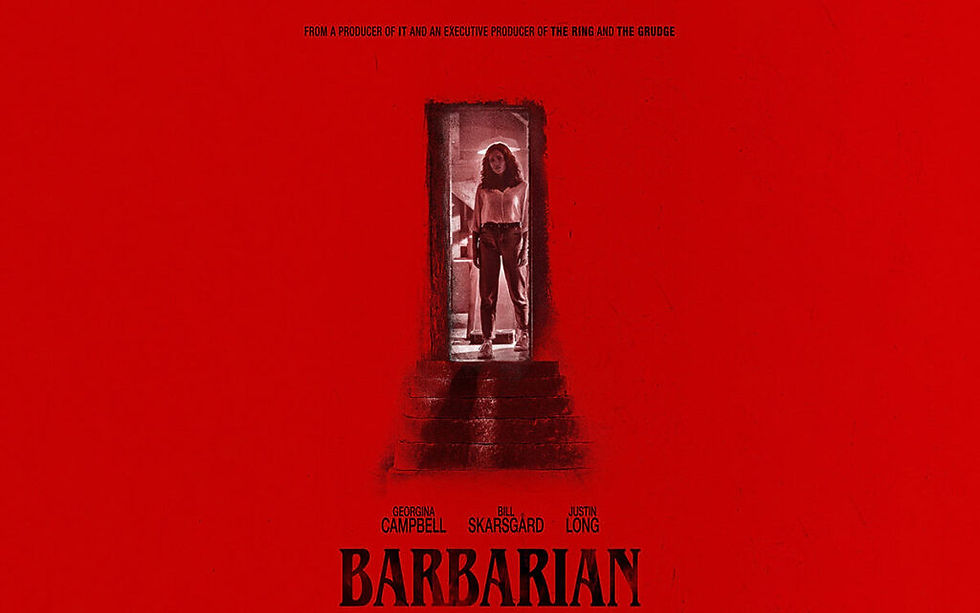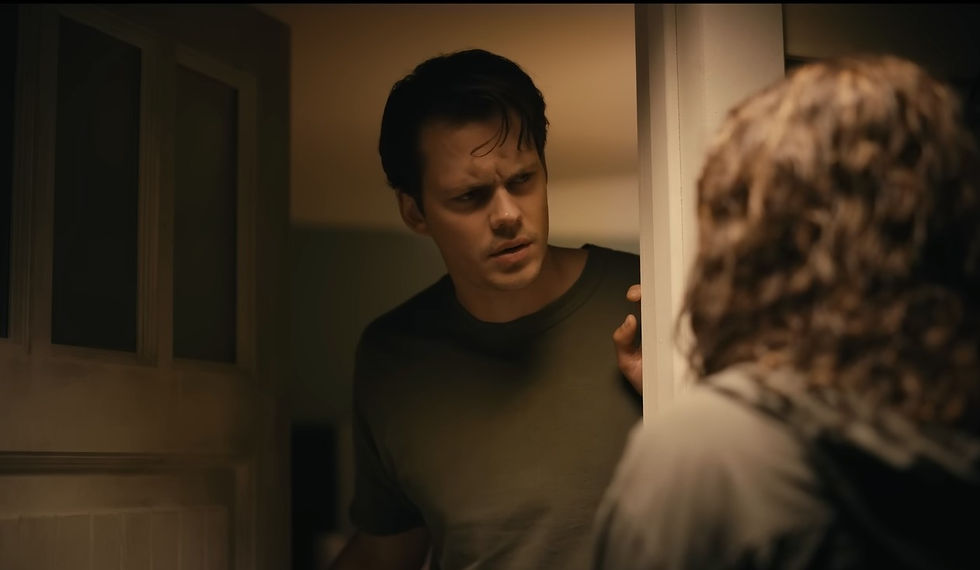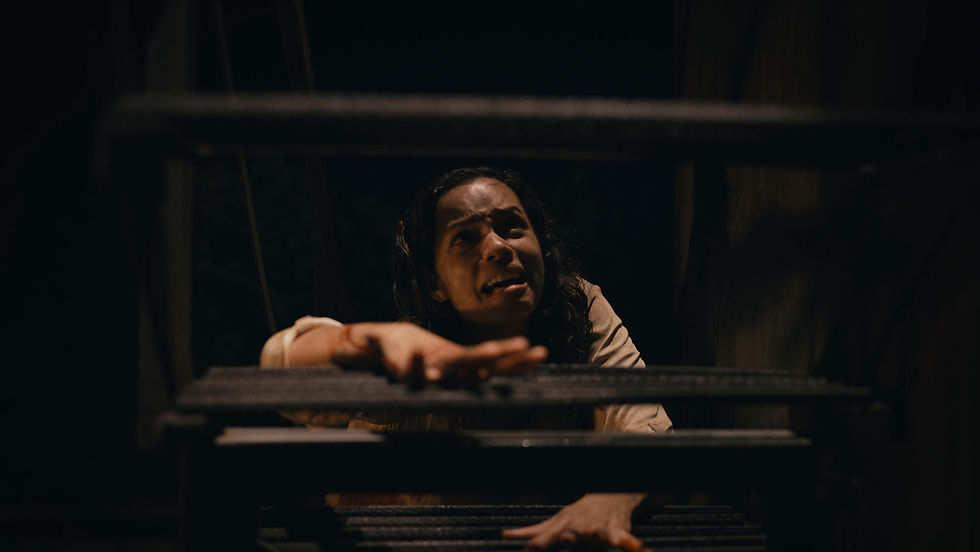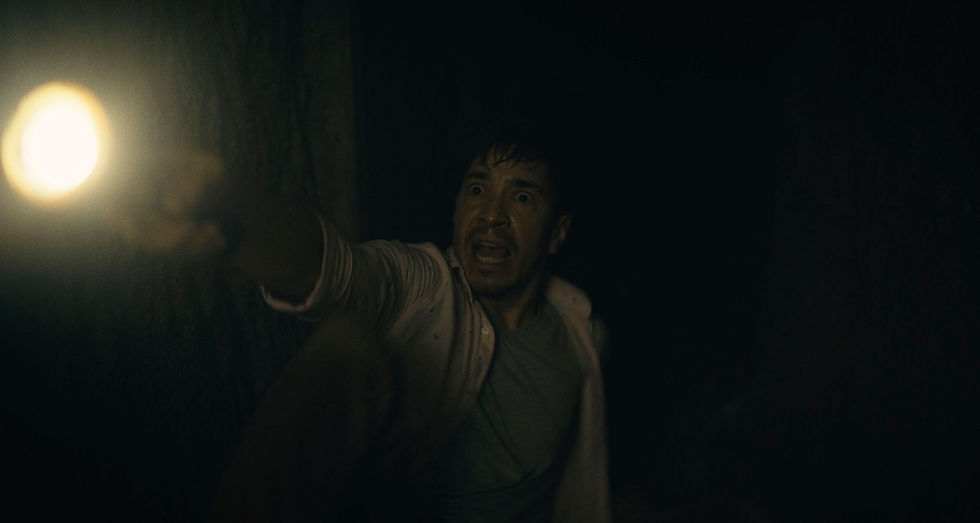"Barbarian" Review: A Visceral AirBnB Nightmare
- Vega

- Sep 12, 2022
- 6 min read
Updated: Nov 13, 2022
Release Date: September 9, 2022 Platform: In Theaters Genre: Horror

After building a good deal of positive press following its initial showing on July 22 at San Diego Comic-Con, Zach Cregger’s directorial horror debut has finally made its way to theaters. Very little has been offered regarding trailers and footage, with most of the anticipation for this film being built off of its reviews. I agree with those recommending that audiences go in with as little knowledge as possible, as some of the movie’s more interesting elements are best delivered when unexpected. This is also a great theater experience with enough to elicit multiple audience reactions, as it was in my theater, with the shrieks and screams only adding to the fun of the genre. If you have not seen the film, you should not read this or any other review before buying a ticket and giving yourself the pleasure of the experience. For those who have seen it or are not cautious of spoilers, let's dive in to one of the best horror experiences of the year.
Establishing its premise early, the movie wastes no time in introducing lead character Tess (Georgina Campbell) and the unsettling situation of finding her Airbnb rental already occupied by Keith (Bill Skarsgård). His rambling and acknowledged suspicion that Tess holds towards him creates a discomfort that Keith is carrying bad intentions towards his temporary housemate. A late night conversation between the two establishes a commentary about stranger danger and women’s intuition. These hints continue to raise suspicions that build the subtlest sense of tension as Tess sleeps through the night, while awaiting the inevitable advantage that Keith is primed to take of the situation. After Tess discovers a secret room in the basement that alludes to a violent past, the false build to Keith’s villainous turn reaches such a satisfying point before Cregger pulls the rug out from under the audience with a satisfying visceral jump scare that establishes the real fear of this story and evades falling into the crowd of recent socially conscious horror movies. As the characters traverse the dark tunnels beneath the house, they come face to face with a towering, deformed nude female best labeled the Mother (Matthew Patrick Davis). Before Tess and Keith’s fates are known, the movie works to defy expectations by immediately cutting away from the heightened response and to an entirely new portion of the plot.

Escaping the Mother’s dingy lair and being suddenly flashed with sunlight on the Pacific Coast Highway, we are introduced to a new character, AJ (Justin Long), who is an actor under investigation for sexual assault. This leans into the second socially relevant topic, the “MeToo” movement, but like the previous commentary topic, it takes a backseat to the film’s more classic horror elements. With lawsuits threatening to leave him broke, AJ travels to Detroit to prepare one of his rental properties for sale; the same property in which Tess and Keith resided two weeks prior. Before being integrated to the greater overall narrative of the Mother’s underground dwelling, AJ serves first as a comedic pallet cleanser. Whereas Tess found concern in the creepy secret tunnel, AJ pulls out his measuring tape in excitement for the additional square footage with which he can market the house. Laying out one of the two key examples of men not needing to be as cautious as women in today’s society, AJ also exists as the villain of the film’s social commentary. It lends to an interesting dynamic throughout the rest of the film between the Mother, Tess, and AJ, particularly concerning what I consider another theme of the film: the nurturing and protective nature of women.
Once his careless exploration of the tunnels brings him into contact with the Mother and, subsequently, trapped with Tess, AJ provides the opportunity Tess needs to escape. Once out of the house, she encounters a homeless man with knowledge of the happenings in that house over the past few decades. Ignoring his warning, Tess leans into her protective nature and fights against her own intuitions from earlier in the movie to return with help for AJ. Her inclination transitions, again, away from the heightened emotions of the situation and into another related narrative, that of the original owner, Frank (Richard Brake) and the origins of the current situation. I much prefer that the movie took time to do some background work and tell a complete story, rather than leave breadcrumbs for a prequel. It also proves necessary for understanding the motivations behind the character’s final acts and Tess’s last moment of hesitation, both of which end up painting the Mother in a different light. Whether your perspective maintains a creature feature or a psychological dive into the monster of rape, the film’s almost sudden conclusion leaves both ends of the spectrum with an eye-opening splatter.
From a technical side, the movie’s jarring edits that cut away from high tense situations felt off-putting (which may be the intention). It brought a unique flavor to the story and allowed the story to maintain better control of the emotional beats. Rather than sit in the ongoing sense of dread, which the story produced very well between the cuts, the ever shifting story pulls audiences out of that place to prevent desensitization, allowing for greater heights of shock. There were also brief instances of unique camera angles used that added a bit of flair to the dramatics, such as a first-person angle from AJ’s perspective as he shines his flashlight in the darkness. There is probably not much to be found here, but I enjoyed the unique angles, and they were notable enough to mention.

This movie finds its best moments in the thrills of its chase scenes and in the depths of its claustrophobic darkness. Its commentary and themes are far from necessary for enjoying this film and it can function simply on its flashlight and chase devices. Harnessing the spirit of similar scares as the very under appreciated “The Descent” from 2005, the creature lurking in the tightly-knit darkness was a very simple and effective tapping into of innate fears. This movie could have easily maintained a through line of tension, as it did in the first and final acts, and I find that as an essential feature of great horror. But it does not do that. Instead, the director opts for narrative ploys to create emotional uncertainty through its story breaks, leaving just enough time for a smidgen of character work and social relevancy. Tess can be a confusing character at times, both demonstrating common sense safety and horror trope curiosity. When she first encounters the hidden door, her exclaimed “Nope” was met with unison agreement by the audience. However, it is hard to have a horror film without a bad decision and her actions moving forward are all high risk, making her a somewhat inconsistent POV character for a film with such woman-focused social themes.
AJ becomes the more interesting character as he gives the audience something to ponder: is he or isn’t he a bad person. For some that is answered very quickly and for others, that answer comes in the final conflict, but either way, his inclusion complicates the Mother’s role as less monster and more unnurtured protector. As cited earlier, AJ amounts to the biggest antagonist in the story, and in many respects so is Frank, both who commit the film’s biggest sin: rape. While AJ is meet with vengeance by the Mother, Tess demonstrates understanding and compassion towards her, though ever so temporary. The little cracks into these anthropological aspects may give just enough for those who have grown accustomed to the contemporary horror film, while also delivering on its raw thrill.

“Barbarian” has the appeal of capturing the attention of many different horror fans, those looking for allegory and depth and those looking for hard-edged terror. It carries a unique style in its emotional tones and narrative devices to help set it apart, but can also feel too stylized in its editing. I found this to be one of the more enjoyable horror experiences this year and the theater experience might have played a hand in that. So, again, I recommend that you see this on the big screen, even if you have read this or other reviews and have had the film spoiled. While there are some minor twists in the story itself, the bulk of this movie’s experience comes from its visuals, its foreshadowing, and the satisfying increases in blood pressure.
RATING: 🔦 🔦 🔦 🔦 / 5
If you enjoyed this content, please follow Geeky Therapy on Facebook and Instagram to stay up to date with all posts and reviews.






Comments